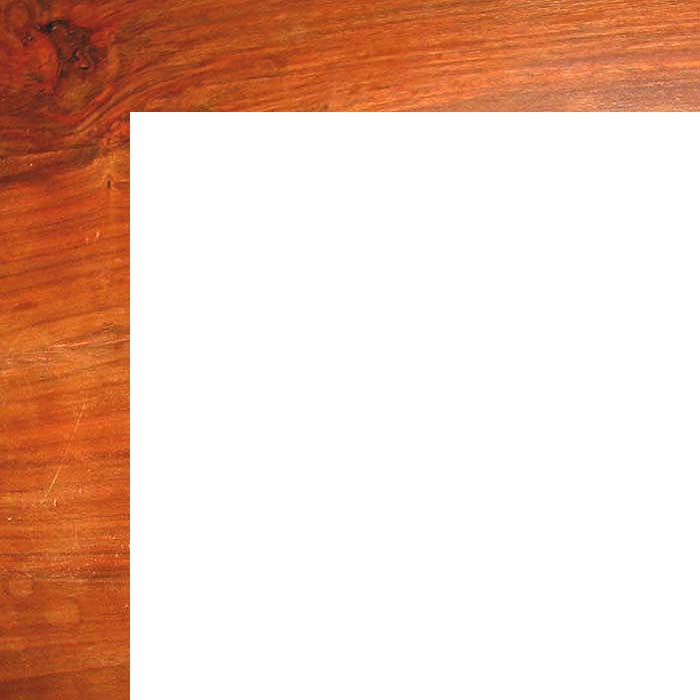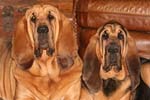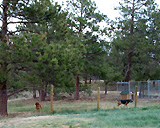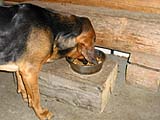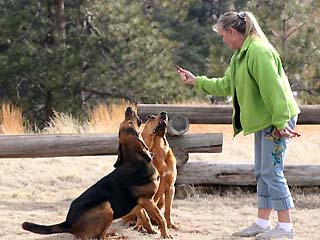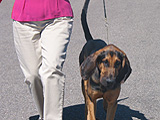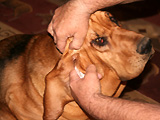ENVIRONMENT
Even a 20 lb bloodhound puppy will grow up to between 100-140
lbs, so a large dog should have a Large Yard with a Good High Fence
(at least 5 feet) and Proper Shelter be it a dog house or access to
something else like a garage or barn. They need shade, so if you
don't have trees, put up some tarps or something for shade. Keep
in mind they are hard on lawns & gardens, so don't have too high
of expectations in their dog area.
FOOD
Bloodhounds do better with 2 meals per day, one AM, one PM.
Check with your bloodhound breeder to see what dog food they
recommend. We recommend a brand where all ingredients come from
the US (Purina or Pedigree). Many bloodhound owners pamper
their dogs with something added to their dry food. It might be
added wet or can food, or added cottage cheese or yogurt, or
another protien (groud meat or liver). The added bonus does not
have to be a lot, (just a quarter cup to intice them to eat better).
Bloodhounds also should be fed in raised bowls (pretty level to
where their mouth is). This is a good practice for any dog; but
it is really essential for bloodhounds.
WATER
Every dog needs water, and bloodhounds drink a lot. Also many
bloodhounds like to dunk & snorkel when they drink (putting most
of their head in the water). So water bowls need to be more like
a bucket. And it is especially important to give clean water daily
and to clean water containers. (Since bloodhounds are messy with
water, many owners keep their water outside only, and that's really
perfectly OK.)
LEADERSHIP & TRAINING
We have mentioned it before, and that is bloodhounds really do
need good leadership or they will definately try to rule over their
humans. They need firm (but gentle corrections); and though they
may often look & act unintelligent - they are really very clever!
If they are inside house pets, they will try to take over furniture
(if you let them). Do remember each dog has a unique personality,
so work on the positives with your dog to develop the best of his
or her character. Along with a good leader, bloodhounds need
some basic training. Teach them to Sit, Stay, Down, Come, Easy
(a command for walking - not pulling on a leash), No (or Leave It)
is really important. And they can learn much more, but you have
to work on teaching them. Puppy Kingerdarden Classes & General
Obiedence Classes are probably a minimum. Many people train their
own dogs very well and that's fine too.
LOVE & ATTENTION
Your bloodhound will not just enjoy your love & attention, but it
will thrive on it. Of course, the opposite can happen as a poorly
treated dog could develop into a poorly behaved dog. And a dog
that is ignored or always caged or kenneled will not develop proper
social skills either. We know everyone treats their pets differently;
but bloodhounds (actually all dogs) deserve a kind, loving family,
where they are part of the family & given attention. Enough said!
GENERAL CARE
* Check their Ears Daily - wipe them out (at least weekly) with
alcohol free unscented baby wipes (clean ears = less ear infections).
* Clean Eyes As Needed (sometimes daily) - a little eye draining can
be expected, so again to prevent a problem keep their eyes clean.
* Brush them at least Weekly (Daily when they are shedding) -
this will keep their coat in good shape; and they love it!
* Check their Waste Weekly - when you are on poop patrol do check
things out as you clean up your dog area. Anything out of the
ordinary, call yout vet.
* Trim their Nails Monthly - start when they are puppies, and have
your vet show you how to do it if you are uncertain.
* Veterinary - Your Vet should help you keep up to date with all
annual shots; and we urge that you get your dog micro-chipped.
|
